The Wheelchair Guide
Your Wheelchair and Mobility Scooter Resource
Medicare and Mobility Scooters
Friday, May 29th, 2009
Medicare is a federally funded insurance program available to most seniors over the age of 65. In addition to covering the types of things you would expect a private insurance plan to cover, Medicare also covers the cost of many types of home medical equipment. Medicare refers to this equipment as Durable Medical Equipment. Mobility Scooters are covered by Medicare and fall into the category of durable medical equipment.
While Medicare does cover Mobility Scooters, there are a few requirements the insured must meet before ordering a mobility scooter. The main requirement is that the scooter is needed for use both in the home and away. If the insured can get around their home without the scooter and only need it when away from home, it would not be covered.
The other main requirement to receive Medicare coverage of a mobility scooter is that a doctor prescribes the scooter as part of a treatment plan. It is important to speak with your doctor prior to ordering the scooter, to ensure that you are eligible to receive a prescription for the device.
If the insured meets these requirements, then Medicare will typically cover 80% of the cost of the mobility scooter. Most mobility scooter dealers will bill Medicare, so once the insured has a prescription, the process typically goes very smoothly. It is also possible to purchase the mobility scooter first and receive reimbursement later, but always make sure you meet the requirements for Medicare reimbursement before doing this.
While almost all of those who use traditional Medicare will be eligible to receive durable medical equipment, such as mobility scooters, those who use a Medicare Advantage Plan, the process might be a little different. Medicare Advantage Plans are optional plans that are still funded by the federal government, but private insurance companies administer the programs. As a result, while a Medicare Advantage Plan will still cover the same things as Medicare, they often go about it in a different manner.
For those who use a Medicare Advantage Plan, it will be necessary to consult the documentation provided by the private insurance company to see how mobility scooters are covered and what the process is to receive reimbursement.
Mobility Scooters for Seniors
Friday, May 22nd, 2009
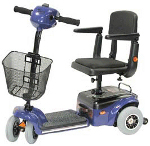 One of the most popular, if not the most popular, mobility aids for seniors is the mobility scooter. Mobility scooters were first developed during the 1960′s and share many similarities with the electric wheelchair.
One of the most popular, if not the most popular, mobility aids for seniors is the mobility scooter. Mobility scooters were first developed during the 1960′s and share many similarities with the electric wheelchair.
An electric motor propels the mobility scooter and it uses one or more batteries, much like a power chair. Often they also share a similar, if not identical captains chair, which includes the same types of features, such as a reclining back, electric lifting system, and swivel controls to make exiting the mobility vehicle much easier.
Like the other two kinds of mobility vehicles, mobility scooters also feature anti-tip casters to prevent the device from tipping over backwards.
However, the physical design of a mobility scooter is actually much different than that of a wheelchair, both electric and manual. This is because they have a much longer wheel base and the captains chair is mounted on the rear of the base.
Mobility Scooter Control Systems
Instead of an armrest mounted joystick, like is used on an electric wheelchair, a mobility scooter is controlled by a set of handlebars, which extends from the front of the scooters base. These handlebars, which are referred to as the tiller, can be adjusted to accommodate riders of different sizes. This allows the mobility scooter’s tiller to be brought closer or moved farther from the captains chair.
Depending on the model of scooter, the tiller might have a headlight, turning signals, battery meters, keyed entry, and troubleshooting gauges on it. Due to the location of the tiller, a mobility scooter can not be driven directly up to a table or desk.
Three Wheeled and Four Wheeled Mobility Scooters
There are a number of different types of mobility scooters available, with many different models available. There are also several ways that an electric mobility scooter can be classified.
One of the most common ways to classify a mobility scooter is by the number of wheels it has. 4 wheeled mobility scooters have two wheels in front and two wheels in the rear. This provides more stability, because as in the case of a rear wheel drive power chair, the weight of the occupant is spread out more evenly. This makes a 4 wheeled scooter more stable than a 3 wheeled scooter.
While a three wheeled mobility scooter might not be as stable as a four wheeled scooter, they are typically much more manuverable and have a turning radius that is considerably smaller than that of a four wheeled scooter. This makes a 3 wheeled scooter preferrable for indoor use. They are also typically lighter in weight.
Different Mobility Scooters for Different Uses
The other way that mobility scooters are classified is by their intended use. For example, there are travel scooters, heavy duty scooters, and traditional scooters.
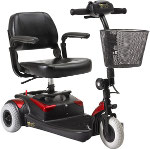 Travel scooters are designed to be as light weight as possible, so they can be taken on vacation or away from the home. They are also designed so that they can be easily disassembled, with all of the pieces being a manageable weight. Often the heaviest piece weighs less than 30 pounds, so most people are able to disassemble it and place it in the trunk of their car or rear seat of their vehicle.
Travel scooters are designed to be as light weight as possible, so they can be taken on vacation or away from the home. They are also designed so that they can be easily disassembled, with all of the pieces being a manageable weight. Often the heaviest piece weighs less than 30 pounds, so most people are able to disassemble it and place it in the trunk of their car or rear seat of their vehicle.
Most travel scooters are three wheeled, as this helps reduce the overall weight of the electric scooter. They also have fewer features, like a scaled back captains chair and no running lights, to further save weight.
Travel scooters do not have the same weight support or range that you could expect from other scooters, but for vacation they can be a great choice.
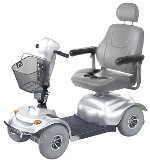 On the opposite side of the spectrum you have heavy duty scooters. A heavy duty mobility scooter is designed to be as rugged and durable as possible. They have the highest weight support, usually feature reinforced bumpers, larger tires, and are packed with features. They are designed, as the name implies, to be used over rough outdoor terrain. Typically, most are four wheeled as this provides the most stability, but there are a few three wheeled heavy duty scooters.
On the opposite side of the spectrum you have heavy duty scooters. A heavy duty mobility scooter is designed to be as rugged and durable as possible. They have the highest weight support, usually feature reinforced bumpers, larger tires, and are packed with features. They are designed, as the name implies, to be used over rough outdoor terrain. Typically, most are four wheeled as this provides the most stability, but there are a few three wheeled heavy duty scooters.
Heavy duty scooters also usually have a very high top speed, large per charge range, and can be a great deal of fun to drive.
While great for outdoor use, since a heavy duty scooter is typically much larger than other electric scooters, it can not be used in some indoor situations and has a much larger turning radius. It also weighs a great deal more so taking it apart and placing it in a vehicle might not be an option for most people. Heavy duty electric scooters are also the most expensive type of mobility scooter.
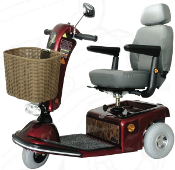 All other mobility scooters fall into the category of traditional scooter. These come in a variety of sizes and while they have many more features than a travel scooter, they have fewer than a heavy duty scooter. Typically though, they will have things like running lights. They come in either 3 wheeled or 4 wheeled designs.
All other mobility scooters fall into the category of traditional scooter. These come in a variety of sizes and while they have many more features than a travel scooter, they have fewer than a heavy duty scooter. Typically though, they will have things like running lights. They come in either 3 wheeled or 4 wheeled designs.
When compared to travel scooters, traditional scooters offer increased weight support, range, top speed, stability, and durability. Like heavy duty scooters, the weight of a traditional scooter often makes disassembling it not an option, because the lightest piece can often weigh well over 70 pounds.
Seniors and Mobility Scooters
Price wise the cost of a mobility scooter usually falls in the middle, between a manual wheelchair and electric wheelchair. They are easy to use and have a greet range, so can be a good choice for a senior who has difficulty walking.
Due to the location of the tiller, you are not able to drive a mobility scooter directly up to a table, which means that some mobility is required of the user in order to get the most benefit out of a mobility scooter.
For someone who can walk, but not for extended periods of time, a mobility scooter would be a good choice. However, for someone who can not walk, a mobility scooter might not be a good choice.
Electric Wheelchairs for Seniors
Thursday, May 21st, 2009
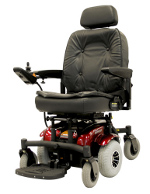 Electric wheelchairs, which are often also called power chairs, offer the advantage of a manual wheelchair, in that they are very maneuverable. However, unlike manual wheelchairs, power chairs are powered electronically, so they can typically be operated very easily, requiring very little physical activity of the senior.
Electric wheelchairs, which are often also called power chairs, offer the advantage of a manual wheelchair, in that they are very maneuverable. However, unlike manual wheelchairs, power chairs are powered electronically, so they can typically be operated very easily, requiring very little physical activity of the senior.
A simple joystick control scheme is most popular for controlling electric wheelchairs, which allows the senior to simply push the joystick. The joystick, which is attached to the arm of the power chair, then moves the wheelchair in the direction they wish to travel. Of course, there are a number of alternate wheelchair control systems available as well, including breath controlled systems and remote controlled systems, which are often used by caretakers.
A Brief Background on Electric Wheelchairs
The first electric wheelchairs, which were developed in the early 1950′s, were simply adapted E & J manual wheelchairs.
An electric motor was attached to the manual wheelchair, which was controlled using a simple joystick control scheme, although even during the 1950′s, researchers were already coming up with alternate control schemes. One popular method was to mount something similar to a joystick near the individuals head. They could then use their face to control the electric wheelchair.
The Modern Electric Wheelchair
Today, while some portable electric wheelchairs do use a traditional steel tubed folding wheelchair design, most look much different from a traditional manual wheelchair. Instead, an electric motor and battery is contained in the base of the wheelchair, usually covered by molded plastic.
A captains chair, which, depending on the cost of the power chair, often rivals that of most office chairs, both in comfort and durability, is mounted on the base of the wheelchair. The captains chair often reclines and swivels, to facilitate comfort and make transferring into and out of the wheelchair easier. Some even include an electric lifting system to raise and lower the chair.
While many power chairs share a similar design, one way they are often classified is by their wheels. A mid-wheel power chair features one set of large wheels in the middle of the base and one set of smaller wheels on the front and back of the base. The larger wheels are what does all of the work and are powered by the electric motor. The smaller set of wheels on either side of the drive wheels, provide extra support and stability.
The mid-wheel electric wheelchair offers the advantage of excellent maneuverability. It can turn in much smaller spaces. However, in some cases it might not offer the same stability as a rear-wheel drive wheelchair. This is because the center of balance for a mid-wheel wheelchair is in the middle of the power chairs base.
The other common type of electric power chair is the rear wheel drive wheelchair. These feature a set of rear wheels, which depending on the model might be slightly larger, and a set of front wheels, giving it four wheels in total. The rear wheels, are powered and what actually moves the power chair.
The rear wheel drive wheelchair does not offer the same maneuverability that a mid-wheel power chair does, but does offer increased stability. This is because the weight of the occupant is more evenly distributed across the base, making a wider center of balance.
As is the case with manual wheelchairs, power chairs, both mid-wheel and rear wheel drive models, include anti-tip casters to prevent the wheelchair from tipping over backwards.
Advantages of Electric Wheelchairs
One of the major advantages that an electric wheelchair offers is that it does not require much effort to use. Simply push the joystick and the power chair will move, with many offer very small turning radius and sensitive controls. The speed is often adjustable and some models can reach speeds of over 10 miles per hour.
The range of a power chair varies, but most can travel at least 5 miles without requring a recharge. Some can travel upwards of 20 or 30 miles per charge, but this often is dependent on the terrain and weight of the occupant. For example, if you decided to drive around the hills of San Fransisco, the battery would wear down much quicker than it would when used on flat land.
Along the same lines, if the rider weighed 300 pounds, the battery would wear down quicker than if they weighed 150 pounds. Often, an extra battery pack is purchased for those who use the power chair continuously, as this way when one battery pack wears down, it can be removed and charged, and the fresh battery pack used.
Electric Wheelchairs and Seniors
While the electric power chair can be an excellent device, especially for seniors, it is often cost prohibitive.
Of the three main mobility options, manual wheelchairs, electric wheelchairs, and mobility scooters, electric wheelchairs are by far the most expensive. When compared to mobility scooters, electric wheelchairs often also have a lower range, lower top speed, and are not as well suited to rough terrain. However, for indoor use, they are usually superior to scooters.
Manual Wheelchairs for Seniors
Monday, May 18th, 2009
For a senior, walking for extended periods of time can often be very difficult, which is often the result of injuries or in some cases diseases, such as arthritis. Finding a way to increase accessibility and mobility is very important and often a manual wheelchair will offer the least expensive option for a senior.
A Brief Introduction to Manual Wheelchairs
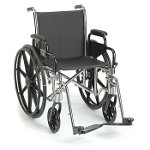 The wheelchair is probably the most well recognized and well known mobility aid, and its origins can be traced back many thousands of years. However, the modern wheelchair, with its steel tubed frame, two large wheels in back, and smaller wheels in front, is actually a fairly recent inventions. These manual wheelchairs, which can be found at virtually any hospital, store, or airport, are based off of the E & J wheelchair, which was first developed and refined during the 1920′s and 30′s.
The wheelchair is probably the most well recognized and well known mobility aid, and its origins can be traced back many thousands of years. However, the modern wheelchair, with its steel tubed frame, two large wheels in back, and smaller wheels in front, is actually a fairly recent inventions. These manual wheelchairs, which can be found at virtually any hospital, store, or airport, are based off of the E & J wheelchair, which was first developed and refined during the 1920′s and 30′s.
The E & J wheelchair, which features lightweight steel tubing and can be easily folded to make transportation easier, is still around today and serves as the basis for most manual wheelchairs. In fact, early electric wheelchairs also used the E & J design. Today there are many adaptations of the E & J wheelchair and many improvements have been made to increase durability, reduce weight, and improve comfort.
Seniors and Manual Wheelchairs
For a senior, a manual wheelchair is often one of the easiest ways to make getting from point a to point b easier. However, using a manual wheelchair requires a good deal of upper body strength, so as a result, most seniors who use manual wheelchairs rely on a family, friend, or caretaker member to push the wheelchair.
Due to their lightweight and lower cost, manual wheelchairs do make an excellent choice for traveling or going places, like an amusement park, where a lot of walking is required. This is of course, as long as there is someone available to operate the wheelchair.
In addition to the large rear wheels and smaller front wheels, manual wheelchairs also include anti-tip casters. Ant-tip casters extend from the rear of the wheelchair, usually at least six inches from the ground. In the event that the wheelchair is tipped backwards, the anti-tip casters make contact with the ground, keeping the wheelchair from completely tipping over.
Seniors and Transport Chairs
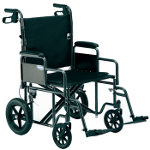 If the senior is not going to be using the wheelchair at all, transport wheelchair, which are also called transfer chairs, are available as well. A transfer chair is similar to a wheelchair, however it does not feature the large rear wheels, which make it possible for the wheelchair user to roll the chair independently, but are instead designed to make it easier for a caretaker or family member to roll the wheelchair. These are often a good choice because they are typically lighter and smaller, making them easier for a caretaker to use.
If the senior is not going to be using the wheelchair at all, transport wheelchair, which are also called transfer chairs, are available as well. A transfer chair is similar to a wheelchair, however it does not feature the large rear wheels, which make it possible for the wheelchair user to roll the chair independently, but are instead designed to make it easier for a caretaker or family member to roll the wheelchair. These are often a good choice because they are typically lighter and smaller, making them easier for a caretaker to use.
Pros and Cons of Manual Wheelchairs for Seniors
While manual wheelchairs or transfer chairs are often the easiest type of mobility aid to procure and are also often the most cost effective option, for a senior, they are often not the easiest type of mobility aid for a senior to use.
For use around the home, it could be a good choice, as they are very maneuverable and in such a small area, it would not require too much effort to use the chair. For long distances though, using a manual wheelchair could quickly become tiring for a senior, so manual wheelchairs might not provide the best choice for a senior who lives independently.